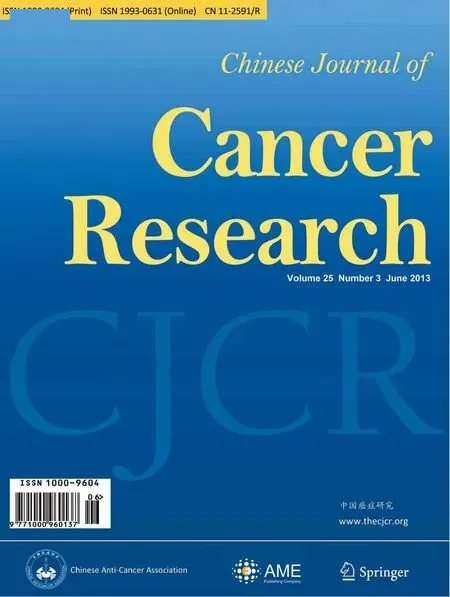Pharmacological blockage of CYP2E1 and alcohol-mediated liver cancer: is the time ready?
Department of Medicine and Alcohol Research Center, Salem Medical Center, University of Heidelberg, Heidelberg 69121, Germany
Pharmacological blockage of CYP2E1 and alcohol-mediated liver cancer: is the time ready?
Sebastian Mueller
Department of Medicine and Alcohol Research Center, Salem Medical Center, University of Heidelberg, Heidelberg 69121, Germany
Corresponding to:Sebastian Mueller, MD, PhD. Department of Medicine and Alcohol Research Center, Salem Medical Center, University of Heidelberg, Heidelberg 69121, Germany. Email: Sebastian.Mueller@urz.uni-heidelberg.de.

Submitted Apr 15, 2013. Accepted for publication May 01, 2013.
Scan to your mobile device or view this article at:http://www.thecjcr.org/article/view/2184/3053
Chronic alcohol consumption is a major risk factor worldwide affecting significantly both mortality and years of life lost (YLL) (1).Ca.5% of the western world show risky alcohol consumption and in some countries such as China a regional yearly increase of alcohol consumption of over 400% has been observed recently (2,3). The liver is the major target organ of alcohol. According to the recently published ‘Global Burden of Disease Study 2010’, liver cirrhosis and liver cancer are ranked at position 12 and 16 in the global deaths statistics (1). Thus, in 2010,ca.1 million people died from liver cirrhosis with one third directly attributable to alcohol. This is a considerable number when comparing with coronary heart disease with 7 million deaths and the leading cause of mortality. In central Europe, liver cirrhosis even ranks at the fourth position in YLL. Hepatocellular cancer (HCC) is now the most common fatal complication of patients with alcoholic cirrhosis. Moreover, it shows the second fastest increase of all tumors worldwide after kidney tumors and alcohol-associated HCC ranks on third position after HCCs caused by viral hepatitis B and C.
These epidemiological data explain the high interest and rationale in better understanding the molecular mechanisms of alcohol-driven hepatocarcinogenesis to identify novel targeted approaches for the future. Indeed, alcohol itself has only recently been recognized as carcinogen. Carcinogenesis by alcohol is complex and still poorly understood which has many reasons (4). First, it is rather the metabolites and side products such as acetaldehyde or reactive oxygen species (ROS) via enzymatic reactions that render alcohol highly toxic. These metabolites are largely dependent on the genetic background, induction kinetics and other detoxifying capacities (5). Second, side products such as ROS are still difficult to measure and to model so that we still lack enough information which species are generated in which compartments and to which extent (6). Finally, animal models drastically differ from humans with regards to alcohol sensitivity, metabolism and consequences namely with regard to the liver.
In this context, the work by Yeet al.deserves great attention and puts our understanding of alcohol-mediated carcinogenesis an important step further (7). In his pioneering work, Charles Lieber could establish the cytochrome P4502E1 (CYP2E1)-dependent microsomal ethanol oxidizing system (MEOS) as an important pathway of ethanol metabolism (8). The induction of CYP2E1 by chronic alcohol intake results in an enhanced activation of procarcinogens to carcinogens, induction of oxidative stress, and release of inflammatory mediators (9). Deletion of CYP2E1 in mice has been shown to decrease ROS and DNA adduct formation (10) and less diethylnitrosamine (DEN)-induced hepatic tumors (11). Notably, the CYP2E1 inhibitor chlormethiazole (CMZ) has been shown to protect from ethanol-induced liver injury in rodents and DNA adduct formation in human hepatoma cells over-expressing CYP2E1 (12). However, a direct evidence of CMZ-protection in ethanol-promoted hepatocarcinogenesisin vivowas still missing.
In the present study, using CMZ as an inhibitor of CYP2E1, Yeet al.demonstrated for the first time a clear role of CYP2E1 in a DEN-initiated but ethanol-promoted hepatocarcinogenesis rat model. CMZ significantly reduced hepatic expression of CYP2E1. They observed significantly more pre-neoplastic lesions (p-GST positivefoci) in ethanol-fed rats without CMZ after one month and independent of DEN. Although the model did not allow to observe carcinoma but adenoma and the group size was limited to six animals, the data are striking and show for the first time a clear protection from ethanoldriven hepatocarcinogenesis using a pharmacological approach. The authors also present first mechanistic insights: In line with previous report (13), ethanolfeeding resulted in significantly decreased levels of cleaved caspase-3, increased nuclear protein expression of NF-κB p65 subunit, cyclin D1 protein and TNF-α mRNA. Thus, increased proliferation and reduced apoptosis seem to be important conditions for carcinogenesis in this model. Notably, CMZ treatment not only prevented alcoholpromoted tumor formation but also restored reduced hepatic retinoic acid which is known to play in important role in tissue differentiation and carcinogenesis. Whether plasma insulin-like growth factor 1 and hepatocyte proliferation also contribute to the CMZ-mediated effects as reported recently remains unclear (14). It would be also very interesting to see whether CMZ could prevent formation of liver cancers in models solely relying on ethanol. Such an ethanol-fed mice model without the use of DEN has been very recently presented by Tsuchishimaet al.(15). These authors observed HCC in 50 % of mice after 70 weeks almost only in the ethanol group with marked upregulation of CYP2E1 and 4-HNE.
The work of Yeet al.opens the fascinating strategy that pharmacological inhibition of CYP2E1per secould prevent the development of alcohol-mediated liver cancers in the future. This is still a long way to go and several questions remain that should be answered in further studies: can these findings be recapitulated in other liver cancer model without cancer-initiating DEN treatment such as described by Tsuchishimaet al.(14)? Is the tumor-inhibiting effect of CMZ restricted to CYP2E1 inhibition or are other mechanisms involved? Can they be observed in humans where CMZ is regularly used for alcohol detoxification? Although CMZ itself has addictive potentials and should not be taken continuously, it could lead to novel alcohol withdrawal regimens or trigger the development of novel CMZ-like drugs with a safer drug profile. So far, data on the hepatoprotective effects of CMZ are not yet available in humans but the time has come to prove these concepts.
Acknowledgements
Disclosure:The author declares no conflict of interest.
1. Lozano R, Naghavi M, Foreman K, et al. Global and regional mortality from 235 causes of death for 20 age groups in 1990 and 2010: a systematic analysis for the Global Burden of Disease Study 2010. Lancet 2012;380:2095-128.
2. Cochrane J, Chen H, Conigrave KM, et al. Alcohol use in China. Alcohol Alcohol 2003;38:537-42.
3. Mueller S, Millonig G, Seitz HK. Alcoholic liver disease and hepatitis C: a frequently underestimated combination. World J Gastroenterol 2009;15:3462-71.
4. Seitz HK, Mueller S. Alcoholic liver disease. In: Dancygier H. eds. Clinical Hepatology: Principles and Practice of Hepatobiliary Diseases. Heidelberg, Dordrecht, London, New York: Springer, 2009:1111-52.
5. Seitz HK, Mueller S. Ethanol metabolism and its consequences. In: Anzenbacher P, Zanger U. eds. Metabolism of Drugs and Xenobiotics. Weinheim: Wiley, 2011.
6. Mueller S, Millonig G, Waite GN. The GOX/CAT system: A novel enzymatic method to independently control hydrogen peroxide and hypoxia in cell culture. Adv Med Sci 2009;54:121-35.
7. Ye Q, Lian F, Chavez PR, Chung J, Ling W, Qin H, Seitz HK, Wang XD. Cytochrome P4502E1 inhibition prevents hepatic carcinogenesis induced by diethylnitrosamine in alcohol-fed rats. Hepatobiliary Surg Nutr 2012;1:5-18.
8. Lieber CS. Cytochrome P-4502E1: its physiological and pathological role. Physiol Rev 1997;77:517-44.
9. Seitz HK, Stickel F. Molecular mechanisms of alcoholmediated carcinogenesis. Nat Rev Cancer 2007;7:599-612.
10. Lu Y, Wu D, Wang X, et al. Chronic alcohol-induced liver injury and oxidant stress are decreased in cytochrome P4502E1 knockout mice and restored in humanized cytochrome P4502E1 knock-in mice. Free Radic Biol Med 2010;49:1406-16.
11. Kang JS, Wanibuchi H, Morimura K, et al. Role of CYP2E1 in diethylnitrosamine-induced hepatocarcinogenesis in vivo. Cancer Res 2007;67:11141-6.
12. Dey A. Cytochrome p450 2E1: Its role in disease and drug metabolism. Dordrecht, Heidelberg, New York, London: Springer, 2013.
13. Chung J, Chavez PR, Russell RM, et al. Retinoic acid inhibits hepatic Jun N-terminal kinase-dependent signaling pathway in ethanol-fed rats. Oncogene 2002;21:1539-47.
14. Chavez PR, Lian F, Chung J, et al. Long-term ethanol consumption promotes hepatic tumorigenesis but impairs normal hepatocyte proliferation in rats. J Nutr 2011;141:1049-55.
15. Tsuchishima M, George J, Shiroeda H, et al. Chronic Ingestion of Ethanol Induces Hepatocellular Carcinoma in Mice Without Additional Hepatic Insult. Dig Dis Sci 2013. [Epub ahead of print].
Cite this article as:Mueller S. Pharmacological blockage of CYP2E1 and alcohol-mediated liver cancer: is the time ready? Chin J Cancer Res 2013;25(3):269-271. doi: 10.3978/ j.issn.1000-9604.2013.05.01
10.3978/j.issn.1000-9604.2013.05.01
 Chinese Journal of Cancer Research2013年3期
Chinese Journal of Cancer Research2013年3期
- Chinese Journal of Cancer Research的其它文章
- Intrinsic apoptotic pathway and G2/M cell cycle arrest involved in tubeimoside I-induced EC109 cell death
- Effect of early enteral nutrition on postoperative nutritional status and immune function in elderly patients with esophageal cancer or cardiac cancer
- New frontiers in peritoneal malignancies
- Risk factors associated with early recurrence of adenocarcinoma of gastroesophageal junction after curative resection
- Hedgehog signaling pathway and ovarian cancer
- Matrix metalloproteinase gene expressions might be oxidative stress targets in gastric cancer cell lines
